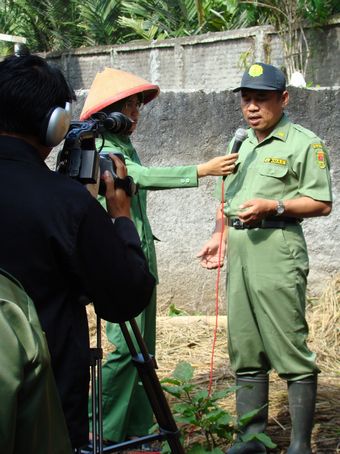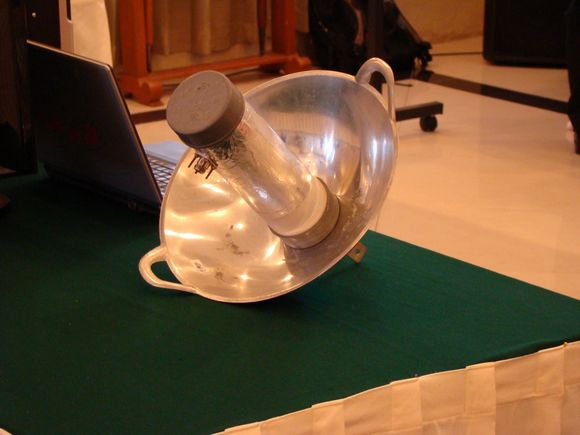Edwin Jurriëns
A wajanbolic antennaEdwin Jurriëns |
While Indonesia’s big cities are saturated with many types of media, media fare at the village level is often quite limited. In response, several grassroots organisations have begun building a more participatory communications infrastructure, relying on advances in technology to provide community television facilities and cheap wireless Internet. Like existing community radio, theatre and print media already scattered across the archipelago, these new media have emerged as an alternative to government and business-controlled Internet and television programming.
Out of the frying pan
In 2000, residents of Timbulharjo village in Bantul, Central Java formed the organisation Angkringan, named after the Javanese term for ‘food vendor’, to build a media infrastructure that would meet the information and communication needs of their community. Starting with an eight-page print bulletin of local news and entertainment, within half a year, Angkringan expanded into community radio broadcasts. During the parliamentary elections of 2004, the organisation used mobile screening facilities to air information about the elections. And in 2007, Angkringan began work on establishing a local Internet network, called AngkringanNet, for Timbulharjo.
AngkringanNet relies on the convergence of community radio broadcasting with wireless Internet technology. Using a community radio antenna, AngkringanNet transmits an Internet signal over the 2.4 GHz frequency, free of charge. The signal can then be accessed by anyone in Timbulharjo with a computer and a ‘wajanbolic’ antenna.
Using wajanbolic receivers, browsing the Internet and sending e-mail is as easy as frying an egg
The wajanbolic antenna is the key to the system: it is composed of an actual wajan, or frying pan, wrapped in aluminium foil and connected to a short tube. Once placed on a rooftop, tree or other elevated point, the linked WiFi USB stick can be connected to one or more personal computers. Users do not have to pay individual Internet connection fees, but can share the costs with other users, keeping the costs per household to only several thousand rupiah per month.
Angkringan’s wajanbolic antenna is based on alternative Internet technology pioneered by the Indonesian technology guru Onno W Purbo and students from Muhammadiyah University in Malang. Angkringan deliberately chose the wajan, a basic piece of cookware that can be found in almost every Indonesian kitchen, to put people with no prior exposure to modern communication technology at ease, and to make it clear that browsing the Internet or sending an e-mail was as easy as frying an egg. The choice can also be seen as a symbol of local resistance against business monopolies dominating the computer and Internet industries.
AngkringanNet provides Timbulharjo residents with Internet links to the outside world as well as an Intranet exclusively for the community. Villagers are encouraged to understand and creatively engage with the technology, and move beyond simply being end users. The AngkringanNet web site makes available various Open Source software programs for villagers to use. They can also contribute to the Village Database, which contains information on local governance, economy, health and other issues.
To date, 12 wajanbolic antennas have been installed in Timbulharjo. In various workshops, Angkringan has shared its ideas and experiences beyond their village with representatives of other Indonesian community media organisations. The Indonesian government, through the Department of Communications (Depkominfo), has also donated computer equipment and provided assistance in Internet training sessions. Angkringan plans to open its wireless service to locally produced community television broadcasts in the near future.
Community content
 |
An interview for Grabag TVEdwin Jurriëns |
Members of Angkringan also helped establish the Association of Indonesian Community Television (Asosiasi Televisi Komunitas Indonesia, or ATVKI), an umbrella organisation of community television stations. Similar to Angkringan’s wajanbolic philosophy, ATVKI defines its community television as ‘from, by and for the people’. ATVKI members exchange technical information and give each other guidance on organisation and broadcast content.
Not coincidentally, ATVKI was founded in Grabag village in Central Java, home of Grabag TV, one of the few active community television stations in Indonesia. Grabag TV was founded in 2005 by Hartanto, a lecturer from the Jakarta Institute of the Arts and native of Grabag. At the time, Grabag residents could only receive the commercial television channel RCTI, relayed from Jakarta by antenna because of the village’s mountainous surroundings. Hartanto built a small studio, provided basic equipment, and organised training sessions on script-writing, filming and editing. Using the existing antenna, villagers began broadcasting programs written and produced by their fellow citizens.
Community TV should broadcast content ‘from, by and for the people’
Currently, Grabag TV has two-hour broadcasts every Monday, Wednesday and Friday afternoon. Any villager with an idea for a program or a general interest in broadcasting is welcome to make a contribution. Farmers and traders go on air to talk about their professional problems, plans and strategies. Programs have featured students from primary and secondary schools discussing the positive and negative effects of television on education, part of Grabag TV’s efforts to raise the media literacy of Grabag’s citizens. The art and culture programs often contain popular Javanese dance and music performances. Grabag TV also organised live coverage of elections for the village head, thus providing a new mechanism for monitoring local political processes.
Costs and controversies
Grabag TV has been able to restrict its average operational costs to only Rp. 800,000 ($A109) per month. It covers these costs with voluntary donations from the viewers. In general, money is an important issue, but not a major obstacle to community initiatives like Grabag TV and AngkringanNet. Often such initiatives find more difficulties in generating innovative and educational media content, and ensuring community participation once the initial enthusiasm has worn off.
Community media also face regulatory and legal hurdles. In the 2003 negotiations over the allocation of broadcast frequencies by the government, community television was passed over while public, commercial and pay television channels were given official broadcast rights, possibly under pressure from the broadcasting industry. The process of receiving a community broadcasting license is also time-consuming and expensive. AKTVI continues to fight for official broadcast frequencies and the streamlining of broadcast licenses.
The work done by organisations like Angkringan and AKTVI illustrates the awareness of Indonesian media activists that the struggle for free and independent information and communication can start, but certainly will not stop, with a WiFi USB stick and a frying pan. ii
Edwin Jurriëns (e.jurriens@adfa.edu.au) is a lecturer in Indonesian Language and Culture at The University of New South Wales, Canberra.
